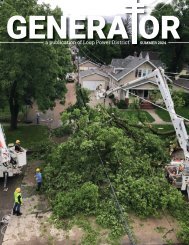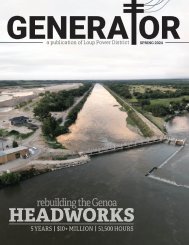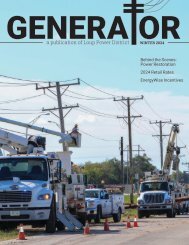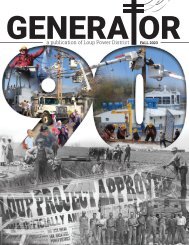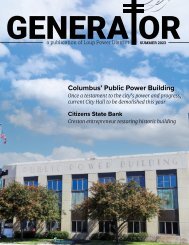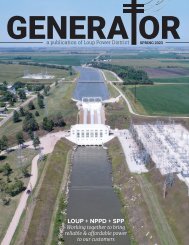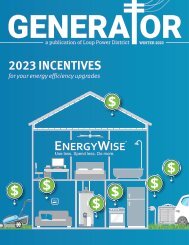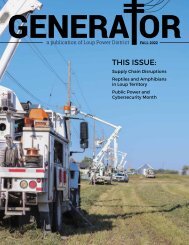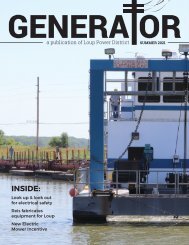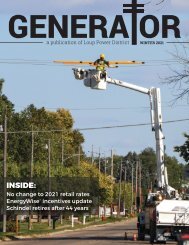Loup Generator - Summer 2020
In this issue: Wetlands & Loup, Ron Ziola reflects on career at Loup, smart thermostats, and more!
In this issue: Wetlands & Loup, Ron Ziola reflects on career at Loup, smart thermostats, and more!
Create successful ePaper yourself
Turn your PDF publications into a flip-book with our unique Google optimized e-Paper software.
GENERA OR<br />
a publication of <strong>Loup</strong> Power District SUMMER <strong>2020</strong>
BOARD<br />
OF DIRECTORS<br />
Chris Langemeier<br />
Chairman<br />
Ross Knott<br />
First Vice Chairman<br />
Alan Drozd<br />
Second Vice Chairman<br />
Steve Heesacker<br />
Secretary<br />
Dick Tooley<br />
Treasurer<br />
Rich Aerni<br />
Robert Cerv<br />
Jim Donoghue<br />
Mike Fleming<br />
Larry Zach<br />
Outdated wiring and overloaded circuits are the most<br />
common causes of electrical fires. Check the following areas<br />
of your home to ensure your electrical safety is up to par.<br />
EXECUTIVE STAFF<br />
Neal Suess<br />
President/CEO<br />
Walt Williams<br />
Vice President,<br />
Accounting & Finance/CFO<br />
Todd Duren<br />
Vice President,<br />
Corporate Services<br />
Ron Ziola<br />
Vice President, Engineering<br />
Dan Hellbusch<br />
Vice President, Operations<br />
The <strong>Loup</strong> <strong>Generator</strong> is<br />
published quarterly as a<br />
service for <strong>Loup</strong> employees,<br />
families, friends and<br />
associates.<br />
For feedback, story ideas<br />
and submissions, contact:<br />
Stacy Wemhoff<br />
Communications Coordinator<br />
402-562-5711<br />
swemhoff@loup.com<br />
ELECTRICAL OUTLETS: Faulty electrical outlets are<br />
a leading cause of home fires. As outlets age, so do<br />
the wires behind them that you can’t see. Any loose,<br />
damaged or warm-to-the-touch outlets should be<br />
repaired or replaced.<br />
OUTDATED ELECTRICAL WIRING: Frequently tripped<br />
breakers, flickering lights and burning smells are clear<br />
warning signs. If your home is more than 20 years old, it<br />
may not be able to handle today’s increased power load.<br />
If you suspect your home’s wiring is outdated, leave this<br />
one to the pros and contact a qualified electrician.<br />
OVERLOADED CORDS AND OUTLETS: Extension cords<br />
are not permanent solutions. If your big-screen TV,<br />
home theater system and other electronics are plugged<br />
into one extension cord, it’s time to call an electrician<br />
and install additional outlets.<br />
OLD APPLIANCES: Older appliances are more likely<br />
to have loose or damaged wiring, which means they’re<br />
more likely to catch fire. Check older appliances for<br />
damage and determine if it’s time to upgrade or replace.<br />
Also check to ensure you’re using appliance-grade<br />
outlets. A qualified electrician can help with installation.<br />
2 GENERATOR<br />
Cover photo by Nebraskaland Magazine/Nebraska Game and Parks Commission
PRESIDENT'S MESSAGE<br />
One constant through<br />
years of challenges<br />
As I approach my 15th anniversary with<br />
<strong>Loup</strong> Power District, I look back at a<br />
number of things that have happened over<br />
the past 15 years, some good and some not<br />
so good. Here are a few examples.<br />
HYDRO RELICENSING<br />
I started on the hydro relicensing project<br />
my first day at <strong>Loup</strong> Power District, and<br />
fifteen years later we are still dealing<br />
with this. Although the District has a new<br />
license (it was issued May 22, 2017), the<br />
terms and conditions are very restrictive.<br />
The District has challenged this license<br />
in the US 8th Circuit Court of Appeals and<br />
we are currently waiting for the Court of<br />
Appeals to review our case. Meanwhile<br />
we continue to negotiate with the Federal<br />
Energy Regulatory Commission and the<br />
United States Fish and Wildlife Service<br />
regarding many of these terms and<br />
conditions. Hopefully a final, acceptable<br />
outcome will be reached soon.<br />
NEW YEAR’S EVE ICE STORM OF 2006<br />
On December 30, 2006, a major ice storm<br />
struck most of Nebraska. The District’s<br />
Albion Division took the brunt of the hit<br />
on the District’s system, with the people<br />
in Petersburg being out of power for at<br />
least four days as District crews worked to<br />
get the subtransmission and distribution<br />
systems up and running. Quite the end to<br />
my first year!<br />
SUMMER HEAT & DROUGHT IN 2012<br />
During the summer of 2012, most of the<br />
Midwestern United States suffered an<br />
incredible drought. The District and other<br />
Nebraska power consumers also saw<br />
the totality of this drought, as NPPD’s<br />
transmission system struggled to keep<br />
up with the increased power usage. After<br />
several days of planning, NPPD and its<br />
wholesale customers devised a unique plan<br />
to make sure the transmission system<br />
stayed intact. This was a long summer<br />
and, due to irrigation, Nebraska came out<br />
ahead, compared to other states.<br />
MID-MARCH 2019 STORM EVENT<br />
Obviously, this event was a huge for me<br />
and for <strong>Loup</strong> Power District. The amount<br />
of precipitation, combined with the frozen<br />
ground and large ice flows on the <strong>Loup</strong><br />
River, created devastation throughout<br />
the District, but most importantly on the<br />
<strong>Loup</strong> Power canal. District personnel are<br />
still working on restoration efforts along<br />
the canal, and it will be later this year,<br />
and into next year before a full recovery is<br />
seen.<br />
PANDEMIC OF <strong>2020</strong><br />
After the storm event in 2019, I really<br />
did not think anything could top that,<br />
but the ongoing COVID-19 pandemic has<br />
really changed the look of our business,<br />
and caused us to look at how we will do<br />
business in the future. This has been a<br />
game changer for many, and I will have<br />
more to say on this in future issues.<br />
One thing though, regarding all of these<br />
events — and any other events that have<br />
happened here during my 15 years at <strong>Loup</strong><br />
Power District — is that when push<br />
came to shove, the people of<br />
the District, the employees,<br />
really came together to fix the<br />
problems and find a solution.<br />
I am extremely proud of<br />
all District employees during<br />
my tenure at <strong>Loup</strong> Power<br />
District and I know they<br />
will continue this in the<br />
future.<br />
They care about each<br />
other and the people<br />
they serve, and it is a<br />
real testament to<br />
what we are as an<br />
organization. Of all<br />
the things that have<br />
happened in the<br />
past 15 years, I can truly<br />
say this is the thing<br />
that I am most<br />
proud of as being<br />
the President/<br />
CEO at <strong>Loup</strong> Power<br />
District.<br />
by NEAL SUESS<br />
President/CEO<br />
SUMMER <strong>2020</strong> 3
CONNOR OLMER<br />
Humphrey St. Francis<br />
—<br />
Plans: Business and economics<br />
at Wayne State College<br />
Son of Tom and Ann Olmer,<br />
Customer Service Representative<br />
AUSTIN CROMWELL<br />
Southeast Community College<br />
—<br />
Associate’s Degree<br />
in Electronic Systems Technology<br />
Working for Electronic Contracting Company<br />
in Lincoln as an Installation Tech<br />
Son of John and Shari Cromwell,<br />
Lead Customer Service Representative<br />
TERRI SEIER<br />
Nebraska Wesleyan University<br />
—<br />
Bachelor’s Degree in English<br />
Minors in writing, psychology,<br />
and modern language literacy<br />
Working for Banyan Medical Systems (Omaha)<br />
with future plans to work in counseling<br />
Daughter of Paul and Shawn Seier,<br />
Customer Service Representative<br />
TREDYN PROSOSKI<br />
Riverside High School<br />
—<br />
Plans: General Studies at Central Community College-Columbus;<br />
Raiders Men’s Basketball Team<br />
Son of Eric and Amber Prososki<br />
Grandson of Sena and Randy Prososki, Headworks Supervisor<br />
MASON PROSOSKI<br />
Twin River High School<br />
—<br />
Plans: Utility Line at Northeast Community College<br />
Son of Eric and Amber Prososki and Betsy<br />
and Kenton Zimmer, Equipment Operator<br />
Grandson of Sena and Randy Prososki, Headworks Supervisor<br />
4 GENERATOR
Area students earn scholarships<br />
LINKAGES SCHOLARSHIPS<br />
Linkages Scholarships were awarded to six students in<br />
the <strong>2020</strong> graduating class at Columbus High School.<br />
The Linkages Program is a nationally recognized program<br />
that supports high schools offering a quality program<br />
of engineering and technology courses. The Columbus<br />
Economic Council, <strong>Loup</strong> Power District, and local<br />
businesses provide support for the program.<br />
The students qualified for the Linkages Scholarship<br />
by taking engineering and technical courses. The<br />
scholarship can be used at each student’s college of<br />
choice.<br />
The <strong>2020</strong> Linkages Scholarships were awarded to the<br />
following students: Clayton Cerny, Rudy Florian, Xsander<br />
Garcia, Sterling Hilton, Justin Holmes, and Kaden Hughes.<br />
The following local sponsors provided financial support<br />
to this year’s program: Behlen Mfg., Columbus Bank,<br />
Columbus Community Hospital, Duo Lift Manufacturing,<br />
Pinnacle Bank, SIDUMP’R, and TORIN Products, Inc.<br />
Since its beginning in 2004, the Linkages Program has<br />
awarded 198 scholarships totaling $60,775.<br />
LOUP POWER DISTRICT SCHOLARSHIPS<br />
<strong>Loup</strong> Power District has awarded scholarships<br />
to eight area students who are attending<br />
Central Community College-Columbus this<br />
fall.<br />
<strong>Loup</strong> Power District scholarships are awarded<br />
to high school seniors living in Boone, Colfax,<br />
Nance, and Platte Counties, and portions of<br />
Madison County.<br />
Selection is based on academic achievement,<br />
employment and school activities, quality<br />
of the personal statement, application<br />
completeness and recommendations.<br />
Scholarships were awarded to: Columbus<br />
High School — Conner Mueller, Walt<br />
Rotherham, and Alexis Martinez; Scotus<br />
Central Catholic High School — Dalton<br />
Borchers; Lakeview High School — Cole<br />
Hobza; Humphrey Public School — William<br />
Whited; Howells-Dodge High School — Wyatt<br />
Hegemann; Twin River Public School —<br />
Mason Prososki.<br />
ELECTRICITY<br />
REMAINS A<br />
GOOD VALUE<br />
The cost of powering your<br />
home rises slowly compared<br />
to other common expenses.<br />
Looking at price increases<br />
over the last five years, it’s<br />
easy to see that electricity<br />
remains a good value!<br />
Average Annual Price Increase 2014-2019<br />
3.7%<br />
3.0%<br />
2.6%<br />
0.4%<br />
Sources: U.S. Bureau of Labor<br />
Statistics, Consumer Price Index<br />
Rent<br />
Medical Care<br />
Education<br />
Electricity<br />
SUMMER <strong>2020</strong> 5
Wetlands and <strong>Loup</strong> Power District have<br />
been intertwined since the first kilowatt<br />
was generated back in 1937.<br />
Over this time, there have been land use<br />
changes, droughts and floods, human<br />
pandemics, and even climate change.<br />
by Dr. Michael P. Gutzmer, Jordan Kort, and Kurt Tooley<br />
New Century Environmental LLC<br />
Photo by Nebraskaland Magazine/Nebraska Game and Parks Commission<br />
6 GENERATOR
Despite these challenges, <strong>Loup</strong> has<br />
continued to produce affordable, reliable,<br />
and efficient hydroelectric power while<br />
improving and maintaining natural<br />
resources and local ecosystems.<br />
This combination is no small task. <strong>Loup</strong><br />
received a new Federal Energy Regulatory<br />
Commission (FERC) license for the<br />
operation of the <strong>Loup</strong> River Hydroelectric<br />
Project in 2017. In its operations, <strong>Loup</strong><br />
must comply with FERC environmental<br />
regulations as well as those from several<br />
state and federal environmental agencies,<br />
like the U.S. Army Corps of Engineers,<br />
the U.S. Fish & Wildlife Service, and the<br />
Nebraska Game and Parks Commission.<br />
Much of this regulation pertains to<br />
the maintenance and conservation of<br />
wetlands.<br />
Wetlands are highly dynamic and<br />
productive systems that produce more<br />
plant and animal life per unit area<br />
than woodlands, prairies, or cropland.<br />
<strong>Loup</strong> operations have promoted the<br />
development of significant wetlands of<br />
various types. Because wetlands occupy<br />
a continuum between wet and dry<br />
conditions, they undergo a variety of<br />
unique changes seasonally, from year-toyear,<br />
and over longer cycles as the climate<br />
changes.<br />
New Century Environmental (NCE) has<br />
assisted <strong>Loup</strong> with various environmental<br />
issues since 2009, including wetlands<br />
assessment, management, and regulatory<br />
compliance.<br />
In 2018 and 2019, NCE assisted <strong>Loup</strong><br />
with environmental permitting for its new<br />
Columbus Service Center and developed a<br />
wetland mitigation site to compensate for<br />
a wetland impacted by its construction.<br />
“Mitigation” is the legally required<br />
construction of a new wetland (usually<br />
at a ratio of two new acres for every<br />
acre impacted) to offset wetlands lost<br />
in developments. The new wetland was<br />
developed near the Oconee siphon.<br />
<strong>Loup</strong> has developed wetland mitigation<br />
sites in the past, but the process is much<br />
more complicated now because of there<br />
are more aspects of wetland ecology to<br />
consider than there were years ago.<br />
The term “wetland” is very inclusive.<br />
A wetland does not always have to be<br />
wet. Wetlands are defined not only<br />
by the presence of water, but also by<br />
characteristic soils and vegetation.<br />
Although things like lakes, ponds,<br />
rivers, and streams are widely recognized<br />
as wetlands, small areas that often<br />
look like fields or meadows can also be<br />
wetlands if they are predictably wet for as<br />
little as 21 days per year.<br />
(continued on page 8)<br />
SUMMER <strong>2020</strong> 7
As a result, there is not one<br />
all-encompassing wetland type.<br />
Swamps, marshes, bogs, fens,<br />
backwater lakes and sloughs, small<br />
streams, shallow ponds, lake and<br />
river shores, wet meadows and<br />
prairies, and bottomland (riparian)<br />
hardwood areas are all considered<br />
wetlands.<br />
Each wetland type has its<br />
own unique set of attributes and<br />
functions. The Fish and Wildlife<br />
Service has developed a technical<br />
classification system to identify<br />
and categorize the various wetland<br />
types. This system categorizes<br />
wetlands by special modifiers<br />
that describe special plants, water<br />
cycles, and soils. The highest level<br />
of classification is the wetland<br />
system, of which there are five<br />
types: marine, tidal, palustrine,<br />
lacustrine, and riverine. Of these<br />
five types, only three occur in<br />
Nebraska: palustrine, lacustrine,<br />
and riverine.<br />
The palustrine system includes<br />
the wetland types most people think<br />
of. These are the soggy, open water<br />
transitional areas (i.e., marshes,<br />
bogs, swamps, bottomland forests,<br />
and small ponds).<br />
Wetlands classified in the<br />
lacustrine system are more<br />
closely associated with open water<br />
areas (i.e., lakes, reservoirs, and<br />
impounded rivers). Wetlands of the<br />
riverine system are associated with<br />
free-flowing bodies of water (i.e.,<br />
unimpounded rivers and streams).<br />
By their very nature, however,<br />
wetlands are dynamic resources.<br />
The characteristics of any given<br />
wetland are constantly in flux. The<br />
biotic communities and physical<br />
qualities that classify a wetland are<br />
always changing.<br />
For example, an area previously<br />
classified as lacustrine may fill<br />
up from the gradual increase<br />
of sediment and deposition of<br />
decaying organic material. After<br />
years of this activity, the physical<br />
changes to the ecosystem and the<br />
biotic community may cause the<br />
wetland to be more accurately<br />
classified as a palustrine marsh.<br />
There are also many other ways<br />
wetlands undergo changes, and<br />
these changes make the monitoring<br />
and management of wetlands an<br />
involved and ongoing process.<br />
<strong>Loup</strong> has been heavily involved<br />
in wetland conservation and<br />
management for decades. Many<br />
benefits of the <strong>Loup</strong> hydroelectric<br />
project are obvious, including<br />
recreation and irrigation. In an<br />
agri-business state like Nebraska,<br />
there is probably no more<br />
important resource than a good,<br />
dependable, and readily available<br />
supply of water.<br />
But there are other benefits as<br />
The environmental<br />
richness and diversity<br />
of <strong>Loup</strong>’s associated<br />
wetlands may be<br />
overlooked at times.<br />
well. The environmental richness<br />
and diversity of <strong>Loup</strong>’s associated<br />
wetlands may be overlooked at<br />
times.<br />
The diversion of the <strong>Loup</strong> River<br />
has increased fisheries, expanded<br />
wetlands, and improved habitat<br />
for waterfowl, shorebirds and<br />
wildlife throughout the project area.<br />
This creates obvious recreational<br />
benefits, but also benefits<br />
threatened and endangered birds,<br />
such as whooping cranes, least<br />
terns, and piping plovers.<br />
As might be expected, the canal<br />
system also provides a unique<br />
aquatic habitat for dozens of native<br />
fish species, from a variety of<br />
minnows to game fish like walleye,<br />
largemouth bass, crappie, and<br />
channel and flathead catfish.<br />
Canal banks with overlying<br />
vegetation provide optimal forage,<br />
spawning and escape cover for a<br />
variety of fish species, especially<br />
during periods of water scarcity<br />
when many other local waterways<br />
run perilously low or dry up.<br />
Overall, the canal and associated<br />
waterways and infrastructure<br />
provide crucial wetland habitats.<br />
Many flora and fauna depend on<br />
this habitat to live and reproduce.<br />
Studies have determined that eighty<br />
percent of American birds rely on<br />
wetlands and the benefits to a wide<br />
variety of wildlife are enormous.<br />
Plants and animals are not<br />
the only reason for wetland<br />
preservation. Wetlands also play<br />
a key role in flood control, ground<br />
water recharge, sediment trapping,<br />
and water purification.<br />
Some studies show that, in<br />
certain instances, wetlands can<br />
remove 70 to 90 percent of nitrate<br />
pollutants — a key function of<br />
water purification that is especially<br />
8 GENERATOR
important in areas with extensive<br />
agriculture, like our area of<br />
Nebraska.<br />
As many wetlands have been<br />
drained and destroyed over the<br />
past 100 years, the <strong>Loup</strong> Project<br />
has provided wetland stability<br />
and enhancement in our region<br />
of the state, and even though the<br />
canal is a man-made structure, it<br />
provides environmental benefits<br />
that would not otherwise exist.<br />
<strong>Loup</strong> Power District has been<br />
reliable and an affordable electric<br />
provider for almost a century. It<br />
has done so while maintaining<br />
environmental compliance and<br />
stewardship.<br />
There is no doubt — after all<br />
this time — that <strong>Loup</strong> Power<br />
District and Nebraska wetlands<br />
are a good mix.<br />
—<br />
Mike Gutzmer, principal of New Century<br />
Environmental and environmental<br />
contractor for <strong>Loup</strong>, is co-writing “Aquatic<br />
Plants of Nebraska” with illustrations<br />
by local artist Dillon Krueger. The book<br />
is scheduled for publication in mid-2021<br />
and will feature an in-depth visual<br />
description of some of the most common<br />
and unique aquatic plants found across<br />
Nebraska wetlands, including many of the<br />
wetland plants that occupy <strong>Loup</strong> wetland<br />
complexes.<br />
Gutzmer and Robert Kaul (Professor<br />
Emeritus of Botany-UNL) discovered and<br />
formally documented American lotus,<br />
Nelumbo lutea, at Lake Babcock in 1997.<br />
Gutzmer and Kaul published the “Aquatic<br />
Plants of Nebraska” poster in 2001<br />
through the University of Nebraska State<br />
Museum.<br />
Journeyman Lineman Zach Reicks<br />
installs a bird diverter on a 34.5kV power<br />
line at Wilkinson Wildlife Management<br />
Area near Platte Center in 2016.<br />
The diverter installation was part of a project to<br />
ensure the safety of cranes and other migratory<br />
birds at Wilkinson. It was funded in part by a grant<br />
from the Nebraska Environmental Trust. In 2017, <strong>Loup</strong><br />
buried a 12.5kV line at Wilkinson to help protect birds.<br />
More diverters are being installed this year on lines<br />
over the <strong>Loup</strong> River and near the Genoa Headworks.<br />
Photos on Page 8 by Michael Gutzmer<br />
Top: Persicaria amphibia (water smartweed) is an emergent aquatic plant and<br />
perennial aquatic herb. It is native to Nebraska and found in several locations within<br />
the <strong>Loup</strong> Power District project area. Some smartweeds are common across the<br />
state.<br />
Middle: Sagittaria latifolia (common arrowhead) is a common emergent aquatic<br />
plant found near the Headgates and in Lake Babcock. It is valuable to wildlife and<br />
provides good habitat. Native Americans and prairie pioneers used its root (tuber)<br />
for food.<br />
Bottom: This tri-colored heron is an example of many of the shorebirds that use<br />
wetland habitats across the country. Great blue herons and black crowned night<br />
herons can be seen in the <strong>Loup</strong> Power District area.<br />
Below: A Canada goose in a wetland on Prairie Wolf Wildlife Management Area<br />
near Genoa in Nance County. Photo by NEBRASKAland Magazine/Nebraska Game<br />
and Parks Commission.<br />
—<br />
New Century Environmental LLC,<br />
a small consulting business in<br />
Columbus, Nebraska, employs a team<br />
of environmental and ecological<br />
professionals that provides quality<br />
environmental services. The company<br />
was formed in 2007 and offers a full<br />
array of services and products to enhance<br />
environmental compliance, resource<br />
management and safety. NCE has<br />
provided environmental support for <strong>Loup</strong><br />
during the FERC environmental study<br />
process.<br />
SUMMER <strong>2020</strong> 9
Clean water? Flood protection? Wildlife habitat?<br />
Not without w<br />
With waterfowl seasons upon us, duck and goose<br />
hunters certainly appreciate the value of wetlands. But<br />
wetlands do much more than provide habitat for ducks<br />
and geese. One of the most productive ecosystems in<br />
the world, wetlands host a variety of plant and animal<br />
species. They also provide numerous other benefits,<br />
including slowing runoff to reduce flooding and filter<br />
pollutants and recharge groundwater, making their<br />
preservation important to all of us.<br />
Nebraska has diverse wetlands across the state, in<br />
every county. There are many types of wetlands:<br />
What we lose...<br />
Sufficient<br />
clean water<br />
95%<br />
of Nebraska drinking water comes<br />
from groundwater, which is<br />
naturally filtered by wetlands.<br />
!<br />
Oxbows<br />
Wet Meadows<br />
Forested<br />
Swamps<br />
Over the past 250 years, wetlands have declined at<br />
an alarming rate, mostly due to land conversion.<br />
Only half the<br />
world’s wetlands<br />
remain intact.<br />
Lakes<br />
Marshes<br />
Playas<br />
Today, only 65%<br />
of Nebraska’s<br />
wetlands<br />
remain intact.<br />
Fens<br />
River and Stream<br />
Backwaters<br />
Seep<br />
Areas<br />
Only 10% of the<br />
Nebraska Rainwater<br />
Basin playa wetlands<br />
remain intact.<br />
Wetlands filter pollutants<br />
from runoff and improve water<br />
quality in streams and the<br />
underground aquifer, reducing<br />
the need for costly treatment.<br />
Groundwater recharge<br />
Many wetlands slowly<br />
release water into the ground<br />
to recharge groundwater.<br />
Sandhills and playa wetlands<br />
recharge a significant portion<br />
of the state’s Ogallala Aquifer.<br />
Because of the Clean Water<br />
Act, the Farm Bill, State Title<br />
117, and other federal, state,<br />
and local protections, we have<br />
effectively slowed the rate at<br />
which we are losing wetlands.<br />
3,000,000<br />
2,000,000<br />
1,000,000<br />
0<br />
Estimated acres of wetlands in Nebraska<br />
1972 Clean Water Act<br />
1770 1800 1830 1860 1890 1920 1950 1980 2010<br />
10 GENERATOR
etlands<br />
...when we lose wetlands:<br />
Diverse wildlife<br />
Nebraska is unique in that it possesses<br />
three major wetland complexes – the<br />
Sandhills, the Rainwater Basin, and the<br />
Platte River – that are of international<br />
importance to wildlife. Wetlands play an<br />
important role by providing habitat for<br />
threatened and endangered species.<br />
38%<br />
of reptiles<br />
100%<br />
of amphibians<br />
70%<br />
90%<br />
of the continent’s sandhill crane<br />
population uses the Platte River for roosting habitat.<br />
Nebraska species relying on wetlands:<br />
36%<br />
of mammals<br />
of the state’s threatened<br />
and endangered<br />
species, such<br />
as piping plovers<br />
and whooping cranes,<br />
depend on wetlands.<br />
50%<br />
of birds and plants<br />
Revenue in tourism and<br />
hunting recreation<br />
Streams and wetlands are major economic<br />
drivers because of their role in hunting,<br />
fishing, recreation, and agriculture. In the<br />
Rainwater Basin landscape, every acre<br />
generates $20 per year in revenue.<br />
Protection from<br />
disaster<br />
Wetlands hold<br />
water, making<br />
flooding and soil<br />
erosion less likely.<br />
$<br />
DESIGN AND GRAPHICS BY MEL SEVERIN | NEBRASKA GAME & PARKS COMMISSION<br />
Conservation Programs<br />
Wetland conservation programs like the USDA’s Wetland Reserve<br />
Easement Program (WRE, formerly called Wetlands Reserve<br />
Program or WRP), provide alternatives for flood-prone cropland,<br />
helping producers reduce input costs and maximize net farm<br />
income. There are numerous other voluntary incentive programs<br />
for wetland conservation provided by federal, state, and local<br />
agencies. More than 100,000 acres have been conserved over the<br />
past 25 years, through a variety of methods including protection,<br />
restoration, management, inventory, research, and education.<br />
We need to continue to conserve<br />
wetlands and maintain the funding<br />
for conservation programs or we<br />
will see a rapid decline once again.<br />
LEARN MORE AT<br />
NebraskaWetlands.com<br />
SUMMER <strong>2020</strong> 11
Ron Ziola began planning his<br />
retirement from <strong>Loup</strong> Power District<br />
more than a year ago.<br />
He imagined that his last year<br />
would be much like the previous 32<br />
years — an enjoyable job filled with<br />
great people, variety, and challenge.<br />
And it was so with one exception<br />
— more challenge that he could have<br />
imagined.<br />
Last March, the Genoa Headworks<br />
faced catastrophic damage following<br />
a storm that dumped rain on frozen<br />
ground. The rising <strong>Loup</strong> River<br />
breached the canal in several places,<br />
causing uncontrolled river flow in<br />
and out of the canal.<br />
Ziola helped coordinate assistance<br />
from the Nebraska National Guard.<br />
The troops helped close a major<br />
breach with 125 sandbags weighing<br />
1,500 pounds each. The damage<br />
estimate is more than $20 million.<br />
Then, a year later, the Covid-19<br />
pandemic hit. Ziola and other<br />
managers at <strong>Loup</strong> had to determine<br />
how to best protect employees and<br />
reduce risk. Most employees had<br />
to adjust to working from home on<br />
rotating schedules.<br />
Even though these challenges<br />
were tough, Ziola knows there’s a<br />
solution to every problem and he<br />
enjoys looking for it.<br />
“That’s what made it a great<br />
career,” he said.<br />
MATH & SCIENCE<br />
Ziola says he was always<br />
interested in math and science. He<br />
kept a scrapbook of articles about<br />
the Project Mercury and Project<br />
Gemini spaceflight programs in<br />
the 1960s, hoping to one day be an<br />
astronaut.<br />
His classmates knew to pick him<br />
first for math and science contests<br />
(but not the spelling bees). He took<br />
college prep courses like math,<br />
physics, and chemistry at Columbus<br />
High School before heading to Platte<br />
Junior College.<br />
He thought about becoming an<br />
architect, but felt he was lacking the<br />
imagination. Algebra teacher was<br />
also on the radar, but wasn’t sure<br />
about that either.<br />
Ziola earned his Associate’s<br />
Degree in 1975, and went on to the<br />
University of Nebraska Lincoln. It<br />
was time to nail down a major.<br />
“I wanted to learn how a<br />
television worked, so I decided on<br />
electrical engineering,” he said with<br />
a laugh.<br />
Wanting to learn how things<br />
work wasn’t new to Ziola. He grew<br />
up watching his father pull things<br />
apart, fix them, and put them back<br />
together.<br />
“He could fix anything and<br />
everything from a semi to a slide<br />
projector,” he said.<br />
His father suggested that he focus<br />
on designing equipment rather than<br />
fixing it. That’s exactly what he<br />
went on to do.<br />
VP OF ENGINEERING<br />
Ziola graduated from UNL in 1978<br />
and began designing substations<br />
at Nebraska Public Power District<br />
(NPPD). He already had experience<br />
there, working as a co-op engineer<br />
in the summers of 1976 and 1977.<br />
While he enjoyed his work there,<br />
Ziola began yearning to expand his<br />
experience. When an Engineering<br />
Supervisor job opened at <strong>Loup</strong>, he<br />
knew he had to apply.<br />
“It was a chance for a new<br />
experience and a step up,” he said.<br />
It also brings us back to all<br />
those challenges he faced over the<br />
years. In his roles as Engineering<br />
Supervisor and Vice President of<br />
Engineering, Ziola has been involved<br />
in many day-to-day challenges as<br />
well as some major projects.<br />
In 2005, <strong>Loup</strong> began a threeyear<br />
hydro rehabilitation project<br />
at the powerhouses in Monroe and<br />
12 GENERATOR
Columbus — the first major upgrade<br />
since the plants began generating<br />
power in 1937. <strong>Loup</strong> issued $17<br />
million in bonds to pay for the<br />
project.<br />
Ziola has also been working on<br />
the new hydroelectric license for<br />
almost 13 years. It was a lengthy<br />
process and although <strong>Loup</strong> received<br />
its license in 2017, he continued<br />
working to resolve some contested<br />
provisions.<br />
Daily tasks included substation<br />
design, new transformers, rebuilt<br />
lines, new breakers and panels.<br />
Ziola estimates the cost of all these<br />
projects to be hundreds of millions<br />
of dollars.<br />
Those dollars are<br />
well-spent because<br />
they ensure reliable<br />
service for <strong>Loup</strong>’s<br />
customers. Ziola<br />
credits <strong>Loup</strong>’s managers and Board<br />
of Directors for seeing the value in<br />
those upgrades.<br />
“We want quality equipment,” he<br />
said. “We don’t need a Cadillac or<br />
Rolls Royce, but we want at least a<br />
Buick.”<br />
<strong>Loup</strong>’s dedication to economic<br />
development also demands that<br />
<strong>Loup</strong> respond to company needs or<br />
prepare for them ahead of time.<br />
“Our basic system is built for<br />
expansion,” he said. “We want to be<br />
ready for the future.”<br />
Over the years, Ziola has definitely<br />
noticed the technological upgrades<br />
that have made engineering<br />
jobs easier. These include cell<br />
phones, a digitized mapping<br />
system, Supervisory Control And<br />
Data Acquisition (SCADA), load<br />
management, and AMI automated<br />
meters among others.<br />
Still, the basics of the job haven’t<br />
changed —transformers, wire, and<br />
poles are the foundation.<br />
“That’s what our customers<br />
need,” he said.<br />
Our basic system is built for expansion.<br />
We want to be ready for the future.<br />
THE LEADING EDGE<br />
Ziola knows that he will miss<br />
the job. He has learned so much<br />
about the hydro system, the Federal<br />
Energy Regulatory Commission,<br />
project safety, and operations.<br />
He will miss the people more.<br />
“My success has been because of<br />
the people around me,” he said.<br />
That includes those outside of his<br />
department. He was amazed by the<br />
work of the hydro and operations<br />
crews following the storm in 2019.<br />
Still, he knows it’s time. He and<br />
his wife, Peg, both enjoy golfing and<br />
international travel. There will be<br />
plenty of that on the agenda when<br />
it’s safe to do so again.<br />
He also wants to visit some of the<br />
breweries and restaurants around<br />
Nebraska. He’s already got Nebraska<br />
baseball tickets.<br />
The Ziolas are also looking<br />
forward to spending more time with<br />
their two grandchildren — Jordyn,<br />
12; and Jayson, 10.<br />
Ziola never dreaded coming to<br />
work and can’t believe how<br />
fast 33 years have gone. He<br />
says he won’t come into<br />
work anymore, but he’ll<br />
never really leave the job.<br />
“There are so many<br />
fun things coming up in the future<br />
that are really going to challenge the<br />
District and management,” he said.<br />
These include conversions,<br />
streetlights, hydro operations, LED<br />
lights, and energy contracts. He’ll be<br />
watching quietly to see if any of his<br />
plans come to fruition.<br />
Deep down, he knows they will.<br />
“We’re going to be on the leading<br />
edge as we always have been.”<br />
SUMMER <strong>2020</strong> 13
employee notes<br />
ROD ZAREK<br />
Plant Operator<br />
Retired<br />
Plant Operator Rod Zarek has retired from <strong>Loup</strong> Power District after more than 25 years<br />
of service.<br />
Zarek joined <strong>Loup</strong> in 1994 as a Maintenance Man with the District’s Columbus Canal<br />
Crew. He transferred to <strong>Loup</strong>’s Columbus Retail Division in 1998 as a Groundman. He was<br />
promoted to Apprentice Lineman in 2000 and to Plant Operator the following year.<br />
As a Plant Operator, Zarek was a member of the team of six Plant Operators who<br />
operate the control room and watch over <strong>Loup</strong>’s hydroelectric system. He controlled the<br />
three generation units at the Columbus and Monroe powerhouses.<br />
Zarek also worked closely with the Genoa Headworks staff to divert <strong>Loup</strong> River water<br />
into the canal system for power plant generation. Other duties included coordinating<br />
generation with NPPD’s control center in Doniphan and monitoring <strong>Loup</strong>’s 115 kV and<br />
34.5 kV subtransmission system.<br />
Zarek is a graduate of Fullerton High School. He and his wife, Marjorie, live in<br />
Columbus and are the parents of four children — Megan, Alecia, Nick, and Zach.<br />
Welcome<br />
JUSTIN SHANLE<br />
Drafting Technician<br />
Justin Shanle of Columbus joined<br />
<strong>Loup</strong> Power District as Drafting<br />
Technician.<br />
Shanle’s duties include revising<br />
distribution and rural maps using<br />
AutoCAD software; assisting with<br />
line and substation projects; and<br />
revising structural, mechanical, and<br />
electrical technical design drawings.<br />
Shanle is a graduate of Scotus<br />
Central Catholic High School. He<br />
earned a degree in Electromechanical<br />
Technology from Southeast<br />
Community College in Milford.<br />
He previously worked for Vishay<br />
Dale Electronics as a Process/<br />
Automation Engineering Technician.<br />
1 Year<br />
NANCY NELSEN<br />
Customer Service Rep<br />
Nancy Nelsen of Newman<br />
Grove joined <strong>Loup</strong> Power<br />
District in 2019 as a parttime<br />
Customer Service<br />
Representative in the Newman<br />
Grove office.<br />
Nelsen’s responsibilities<br />
include greeting customers;<br />
processing payments; setting<br />
up, transferring, and closing<br />
service; taking service calls;<br />
and preparing reports.<br />
She graduated from Lincoln<br />
High School and earned an<br />
Associate of Applied Science<br />
degree from Southeast<br />
Community College.<br />
Nelsen and her husband,<br />
Chris, have a daughter, Halie.<br />
Welcome<br />
DEBRA PETSCHE<br />
Customer Service Rep<br />
Debra Petsche of Petersburg<br />
joined <strong>Loup</strong> Power District as a<br />
Customer Service Representative<br />
in the Albion and Fullerton offices.<br />
Petsche’s responsibilities<br />
include greeting customers;<br />
processing payments; setting up,<br />
transferring, and closing service;<br />
taking service calls; and preparing<br />
reports.<br />
She previously worked in<br />
patient financial services at Boone<br />
County Health Center.<br />
Petsche and her husband, Bob,<br />
have three children — Amanda<br />
(Travis) Ray, Travis (Jill) Petsche,<br />
and Eric (Tori) Petsche. They also<br />
have nine grandchildren.<br />
14 GENERATOR
JANICE BRIDGER<br />
Customer Service Representative<br />
Janice Bridger of Fullerton has retired from <strong>Loup</strong> Power District after more than 28<br />
years of service.<br />
Bridger joined <strong>Loup</strong> in 1992 as a regular part-time cashier at the Fullerton Office. In<br />
1998, she was promoted to full-time Steno-Clerk.<br />
In 2009, Bridger’s title was changed to Customer Service Representative and she<br />
continued in that position until her retirement.<br />
Bridger’s responsibilities included greeting customers; processing payments; setting up,<br />
transferring, or closing service; taking service calls; and preparing reports.<br />
Bridger is a graduate of Fullerton High School. She and her husband, Rocky, are the<br />
parents of two children: Kevin and Lisa. They have four grandchildren.<br />
Retired<br />
10 Years<br />
ANN OLMER<br />
Customer Service Rep<br />
Ann Olmer of Humphrey has<br />
served as the regular part-time<br />
Customer Service Representative<br />
for the Humphrey Office since<br />
2010.<br />
Her responsibilities include<br />
greeting customers; processing<br />
payments; setting up,<br />
transferring, and closing service;<br />
taking service calls; and preparing<br />
reports.<br />
A graduate of Lindsay Holy<br />
Family High School, Olmer has<br />
an Associate of Applied Science<br />
Degree in Human Services from<br />
Southeast Community College –<br />
Lincoln.<br />
She and her husband, Tom,<br />
have five children.<br />
1 Year<br />
JACOB CZARNICK<br />
Lineman<br />
Jacob Czarnick of Columbus<br />
joined <strong>Loup</strong> Power District<br />
in 2019 as a Lineman based<br />
out of the Columbus Service<br />
Center.<br />
Czarnick is a member of the<br />
crew that is responsible for<br />
the construction, operation<br />
and maintenance of electric<br />
transmission and distribution<br />
systems in the Columbus area.<br />
Czarnick interned at <strong>Loup</strong><br />
during the summers of 2017<br />
and 2018.<br />
He graduated from<br />
Columbus High School and<br />
earned his Utility Line degree<br />
from Northeast Community<br />
College.<br />
25 Years<br />
BRIAN HERMAN<br />
Lineman/Serviceman<br />
Herman joined <strong>Loup</strong> in 1995 as an<br />
Apprentice Lineman in Fullerton and was<br />
promoted to Lineman later that year. He<br />
was promoted to Journeyman Lineman<br />
in 2000 and transferred to Lineman/<br />
Serviceman in 2018.<br />
Herman’s primary responsibility is<br />
ordering and receiving material (store<br />
inventory) for District operations in the<br />
Fullerton Division service area. He also<br />
conducts monthly substation inspections,<br />
services water heaters, maintains street<br />
lights, and performs other duties for the<br />
Fullerton Division.<br />
Herman is a graduate of Clarks High<br />
School. He earned an Associate of Applied<br />
Science Degree in Utility Line from<br />
Northeast Community College in Norfolk.<br />
He and his wife, Angie, have three<br />
children — Skyler, Spencer, and Stormy.<br />
SUMMER <strong>2020</strong> 15
employee notes<br />
JOE HUBENKA<br />
Humphrey Local Superintendent<br />
40 Years<br />
Hubenka joined <strong>Loup</strong> in 1980 as an Apprentice Lineman at the Columbus Service<br />
Center and was later promoted to Lineman. He was promoted to Journeyman Lineman<br />
in 1984. In 1990, he was promoted to his current position of Humphrey Local<br />
Superintendent.<br />
As local superintendent, Hubenka is responsible for overseeing the maintenance<br />
and construction of <strong>Loup</strong>’s electric power transmission and distribution system in the<br />
Humphrey, Creston, Cornlea, and Tarnov area. He also directs customer service in the<br />
area.<br />
A graduate of Leigh High School, Hubenka earned an Associate of Applied Science<br />
Degree in Utility Line from Northeast Community College in Norfolk. He has four<br />
children — Nathan, Derrick, Marcus, and Alex.<br />
15 Years<br />
5 Years 1 Year<br />
TOMMY WEMHOFF<br />
Journeyman Lineman<br />
Wemhoff joined <strong>Loup</strong> in 2005<br />
as an Apprentice Lineman at the<br />
Columbus Service Center and<br />
was later promoted to Lineman.<br />
He was promoted to Journeyman<br />
Lineman in 2009.<br />
As a Journeyman Lineman,<br />
Wemhoff is member of the<br />
crew that is responsible for the<br />
construction, operation, and<br />
maintenance of <strong>Loup</strong>’s electrical<br />
transmission and distribution<br />
systems and substations in the<br />
Columbus Division.<br />
Wemhoff is a graduate of<br />
Coleridge High School and earned<br />
an Associate of Applied Science<br />
Degree in Utility Line from<br />
Northeast Community College.<br />
RENAE SCHMIDT<br />
Network Coordinator<br />
Renae Schmidt of Columbus joined<br />
<strong>Loup</strong> Power District in 2015 as Network<br />
Coordinator.<br />
She is responsible for developing<br />
and maintaining server and computer<br />
configurations for the District,<br />
including assisting with network<br />
configurations and issues.<br />
Schmidt is a graduate of St. Edward<br />
High School. She earned an Associate<br />
of Applied Science Degree in Data<br />
Processing IT from Central Community<br />
College in Columbus.<br />
She also earned numerous<br />
certifications, including the<br />
following in 2017: Microsoft Certified<br />
Professional, Microsoft Certified<br />
Solutions Associate: Windows<br />
Server 2012, and Microsoft Certified<br />
Solutions Expert: Cloud Platform and<br />
Infrastructure.<br />
BEAU SCHOMMER<br />
Lineman<br />
Beau Schommer joined <strong>Loup</strong><br />
Power District as a Lineman<br />
based out of the Columbus<br />
Service Center in 2019.<br />
He is a member of the<br />
crew that is responsible for<br />
the construction, operation<br />
and maintenance of electric<br />
transmission and distribution<br />
systems in the Columbus area.<br />
Schommer graduated from<br />
Norfolk Catholic High School and<br />
earned his Utility Line degree<br />
from Northeast Community<br />
College.<br />
16 GENERATOR
RON CHRISTO<br />
Cedar Rapids Local Superintendent<br />
Ron Christo of Albion joined <strong>Loup</strong> in 1985 as an Apprentice Lineman in the Albion Retail<br />
Operation. He was promoted to Lineman/Serviceman in 1986 and to Journeyman Lineman<br />
in 1990. He was promoted to his current position of Local Superintendent for Cedar Rapids<br />
in 2015.<br />
As Local Superintendent, Christo oversees the maintenance and construction of <strong>Loup</strong>’s<br />
electric power transmission and distribution system in the Cedar Rapids and Primrose<br />
area. He also is in charge of customer service in the area.<br />
A native of Albion, Christo is a graduate of Albion High School. He earned an Associate of<br />
Applied Science Degree in Utility Line from Northeast Community College in Norfolk.<br />
35 Years<br />
1 Year<br />
DREW GRAHAM<br />
Monroe Chief<br />
Powerhouse Operator<br />
Drew Graham joined <strong>Loup</strong> in<br />
2019 as a Utilityman based out<br />
of the Columbus Service Center.<br />
He was promoted to Monroe<br />
Powerhouse Chief Operator earlier<br />
this year.<br />
Graham is responsible for<br />
the operation, monitoring, and<br />
maintenance of the Monroe<br />
Powerhouse including generators,<br />
auxiliaries, substation, and<br />
structures.<br />
Graham is a native of Silver<br />
Creek and graduated from Twin<br />
River High School. He earned a<br />
degree in Heating Ventilation and<br />
Air Conditioning/Refrigeration<br />
from Northeast Community<br />
College. He and his wife, Jordan,<br />
live in Monroe.<br />
Promotion<br />
TIM RECEK<br />
Equipment Operator<br />
Tim Recek of Columbus was<br />
recently promoted to Equipment<br />
Operator at <strong>Loup</strong> Power District<br />
Recek joined <strong>Loup</strong> Power<br />
District in 2017 as a Utilityman<br />
based out of the Columbus<br />
Service Center. He transferred to<br />
Maintenance Man in 2019.<br />
In his new role as Equipment<br />
Operator, Recek operates the<br />
District’s heavy equipment and<br />
is part of the crew that performs<br />
maintenance on the canal system<br />
from Genoa to Columbus. He also<br />
works at the two powerhouses<br />
when needed, helps build<br />
substations, and maintains District<br />
parks and lakes.<br />
He and his wife, Brenda, have<br />
two children: son, Dylan, and<br />
daughter, Sydney.<br />
Promotion<br />
JOHN YRKOSKI<br />
Meter, Relay & Equipment<br />
Technician II<br />
John Yrkoski of Columbus was<br />
recently promoted to Meter, Relay<br />
and Equipment Technician II.<br />
Yrkoski joined <strong>Loup</strong> in 1987 as a<br />
Maintenance Man on the Columbus<br />
Canal Crew based out of the<br />
Columbus Service Center. In 1991,<br />
he was promoted to Equipment<br />
Operator. In 1992, he transferred<br />
to Meter Reader based out of the<br />
Columbus General Office.<br />
In his new position, Yrkoski is<br />
a member of the team responsible<br />
for installation and maintenance of<br />
substation power equipment. He is<br />
also responsible for service orders<br />
and reading meters.<br />
Yrkoski is a native of Fullerton<br />
and a graduate of Clarks High<br />
School.<br />
SUMMER <strong>2020</strong> 17
employee notes<br />
30 Years<br />
MARK ROMBERG<br />
Senior Engineering Technician<br />
Mark Romberg of Columbus joined <strong>Loup</strong> in 1990<br />
as an Engineering Technician II in the Engineering<br />
Department at the Columbus General Office and was<br />
promoted to Engineering Technician I in 1993. In<br />
2006, he was promoted to his current position of<br />
Senior Engineering Technician.<br />
As Senior Engineering Technician, Romberg’s<br />
primary duties relate to the design of transmission<br />
and distribution lines and substations. This includes<br />
buying right-of-way, surveying, designing,<br />
purchasing materials, and writing work orders.<br />
A graduate of Albion High School, Romberg<br />
attended Southeast Community College - Milford<br />
where he earned an Associate of Applied Science<br />
Degree in Electrical Technology.<br />
He and his wife Tammie are the parents of two<br />
children, Josh and Jaclyn. They have one grandson.<br />
25 Years<br />
MIKE BRABEC<br />
Line Foreman<br />
Mike Brabec of Columbus joined <strong>Loup</strong> in 1995 as an<br />
Apprentice Lineman in the Humphrey retail operation.<br />
He was promoted to Lineman later that year and to<br />
Journeyman Lineman in 2000. In 2007, he was named Local<br />
Superintendent in Clarkson. In 2008, he transferred to the<br />
position of Journeyman Lineman in the Columbus retail<br />
operation. Brabec was promoted to his current position of<br />
Line Foreman at the Columbus Service Center in 2014.<br />
As Line Foreman, Brabec is in charge of the line crew<br />
that is responsible for construction and maintenance of<br />
<strong>Loup</strong>’s electrical transmission and distribution system in<br />
the Columbus Division. The Columbus Division includes the<br />
southeastern part of Platte County and part of Colfax County.<br />
Brabec is a graduate of Clarkson High School. He earned<br />
an Associate of Applied Science Degree in Utility Line from<br />
Northeast Community College in Norfolk.<br />
He and his wife, Lori, have two sons: Gavin and Haden.<br />
DREDGE WINCH REPAIR<br />
The port-bow hauling winch on the Pawnee II Dredge at the<br />
Genoa Headworks was removed and repaired in June.<br />
During dredging operations in May, employees noticed that<br />
the winch was making a loud noise. They discovered the<br />
problem after draining the gearbox oil and found it full of<br />
iron filings.<br />
The dredging needed to continue, so employees changed<br />
the gearbox oil often to make it through the season that<br />
ended June 3.<br />
Luckily, there was a spare gearbox because it takes around<br />
18 weeks to get a new one from Italy. The damaged gearbox<br />
was sent to Baton Rouge, La., for repair.<br />
The gearbox was mostly likely damaged during the March<br />
2019 storm. The winch held the dredge against flood waters<br />
and prevented it from being swept away.<br />
The opposite side starboard-bow winch cable (7/8” wire<br />
rope) snapped leaving only the port-bow winch to hold the<br />
dredge putting extreme stress on the components.<br />
Genoa Headworks employees who assisted with the removal<br />
and repair of the dredge winch are James Reeg, Bob Anderson,<br />
Bryan Tworek, and Joe Kleckner. Photo by Brad Morton.<br />
18 GENERATOR
GET SMART<br />
Heating and cooling costs account for around half of your energy bill.<br />
So when it comes to reducing energy use and cutting home energy costs,<br />
you can make a big impact by programming the thermostat.<br />
The right thermostat settings<br />
could yield energy savings<br />
of 8-15 percent, and new<br />
technology is making it<br />
easier than ever to achieve<br />
those settings.<br />
Smart thermostats are<br />
Wi-Fi enabled and may be<br />
controlled remotely through<br />
a tablet, smartphone, or<br />
voice control. Some models<br />
use multiple sensors to<br />
monitor temperatures in various<br />
parts of the home for more<br />
balanced heating or cooling,<br />
track user temperature preferences,<br />
and use the data to optimize your heating and cooling<br />
schedule. Some are designed for complex multi-stage<br />
systems that will control heating, cooling, dehumidifier,<br />
and ventilation systems.<br />
If you’re interested in controlling your thermostat<br />
with your voice or an app, or in being hands-off and<br />
letting it learn your habits, you should consider a smart<br />
thermostat. To narrow your choices, factor in smart<br />
features, price, and attributes that matter most to you,<br />
such as color, size or style, and make sure the chosen<br />
product supports your HVAC system.<br />
The Nest 3rd Generation Learning Thermostat and<br />
Ecobee4 are the most popular and sophisticated devices<br />
in this category. Both devices are usually priced around<br />
$250, but consumers can easily recoup their money in<br />
energy cost savings.<br />
There are many similarities between the two thermostats.<br />
Both can be adjusted via computer, tablet, smartphone,<br />
Google Assistant, or Amazon Alexa device (the Ecobee4<br />
even has a built-in Alexa-enabled speaker). And both<br />
thermostats can interact with other smart devices<br />
and utilize geofencing—using your phone’s GPS to<br />
determine if you’re home, then automatically adjusting<br />
the temperature. Nest’s geofencing works with multiple<br />
phones, while Ecobee supports just one phone. Ecobee<br />
makes up for this with its more sophisticated sensors.<br />
The Nest and Ecobee offer additional remote sensors<br />
that allow the thermostat to take readings from any<br />
room throughout your home and adjust the temperature<br />
accordingly. This can be an advantage if your thermostat<br />
is located near a draft or in direct sunlight. The Ecobee’s<br />
sensors go one step further with occupancy sensing,<br />
which notices if there is movement in the house in order<br />
to override geofencing if the primary phone user leaves<br />
the house and someone is still there.<br />
While many of the features are similar, there a few that<br />
are notably different and can help you determine which is<br />
right for you.<br />
Nest, powered by a rechargeable battery, is a learning<br />
thermostat. When you begin using Nest, it makes a few<br />
assumptions and creates a baseline for its schedule. As<br />
you adjust the temperature up or down, Nest records<br />
it, and after a week, learns your schedule and the<br />
temperature settings you prefer. From then, it continues<br />
to learn and respond to your adjustments. Nest also<br />
records 10 days of energy use data that shows you a<br />
visual of the times your system turned on and off during<br />
those 10 days. Nest also sends a monthly email report<br />
that includes a summary of your energy use compared to<br />
previous months and other Nest users.<br />
Ecobee must be hardwire installed, utilizes a touchscreen,<br />
and can analyze HVAC data for 18 months. All temperature<br />
and motion data from the thermostat and sensors is<br />
recorded, and can be accessed online by the owner to help<br />
you monitor total energy use, how the weather influences<br />
your use, and how your home efficiency compares to other<br />
users in your area.<br />
The two thermostats also can connect with various energy<br />
devices in your home. Ecobee recognizes dehumidifiers<br />
and ventilators, and Next recognizes heat pumps and<br />
auxiliary heat.<br />
For those looking for a smart thermostat with fewer<br />
bells and whistles, the Honeywell Lyric T5+ is one of the<br />
market’s most popular, priced around $135. While it can’t<br />
sense your presence or learn your schedule, it does have<br />
the geofencing feature and can interact with other smarthome<br />
devices, such as turning on lights when you arrive<br />
or leave home.<br />
Whichever fits your lifestyle and preferences, a smart<br />
thermostat is a good investment that can help you save<br />
energy and money in a more convenient way than ever.<br />
Get up to $100<br />
when you install a smart thermostat!<br />
Learn more at loup.com or call Greg at 402-562-5718.<br />
SUMMER <strong>2020</strong> 19
2404 15th Street | PO Box 988<br />
Columbus, NE 68602-0988<br />
4 x 512 pixels.<br />
5 STEPS FOR SAFE DIGGING<br />
Working on an outdoor project? Always call 8-1-1 first, because you never know what’s below.<br />
Here are five easy steps for safe digging:<br />
1. NOTIFY 2. WAIT 3. CONFIRM 4. RESPECT 5. DIG<br />
CAREFULLY<br />
Call 8-1-1 or make<br />
a request online two<br />
to three days before<br />
you start.<br />
Wait two to three days<br />
for a response<br />
to your request.<br />
Affected utilities<br />
will send a locator<br />
to mark underground<br />
utility lines.<br />
Confirm that all<br />
affected utilities have<br />
responded by<br />
comparing the markers<br />
to the list of utilities the<br />
8-1-1 call center notified.<br />
Respect the markers<br />
provided by the affected<br />
utilities. They are your<br />
guide for the duration<br />
of your project.<br />
If you can’t avoid<br />
digging near the<br />
markers (within 18-24<br />
inches on all sides,<br />
depending on state<br />
laws), consider moving<br />
your project.<br />
2-3



